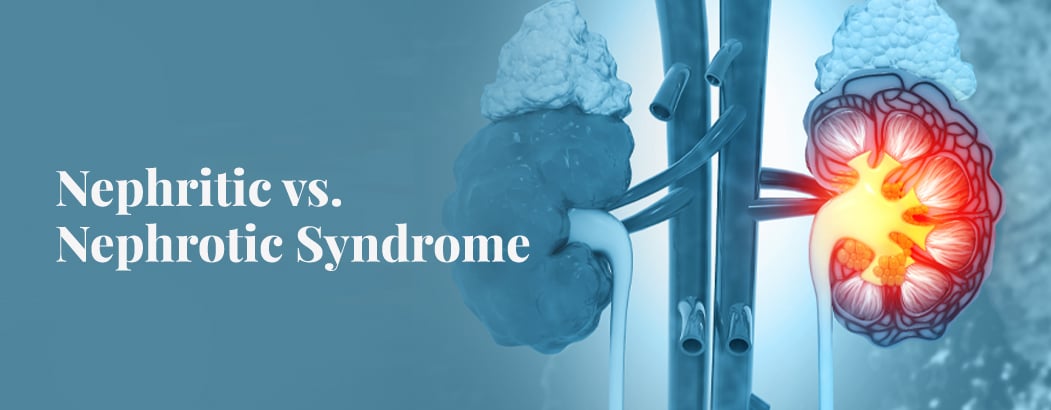What is the Difference Between Nephrotic and Nephritic Syndrome?
August 25, 2023

Understanding kidney conditions can be complex and two terms often come up: “nephrotic syndrome” and “nephritic syndrome.” While they sound alike, they have distinct characteristics, causes and effects on kidney health. In this guide, we will explain the differences between them, including symptoms, causes and treatments. Whether it is for yourself or a loved one, this article aims to make these kidney disorders clearer and easier to understand.
Table of Contents
- What is Nephrotic Syndrome?
- Causes and Symptoms of Nephrotic Syndrome
- What is Nephritic Syndrome?
- Causes and Symptoms of Nephritic Syndrome
- Comparison Table
- Conclusion
- Frequently Asked Questions
Nephrotic Syndrome
What is Nephrotic Syndrome?
Nephrotic syndrome is a kidney condition with symptoms like protein in the urine, low blood protein levels, high cholesterol and swelling. It is caused by underlying kidney issues and needs medical evaluation and treatment. Conditions like minimal change disease, focal segmental glomerulosclerosis or membranous nephropathy can lead to nephrotic syndrome.
Causes of Nephrotic Syndrome
Another prevalent cause of nephrotic syndrome, particularly in adults, is focal segmental glomerulosclerosis. Scarring (sclerosis) in some portions of the kidney’s filtering units, known as glomeruli, characterizes this disorder. Genetic predisposition, viral infections, obesity, and certain drugs can all contribute to FSGS. Scarring reduces the kidney’s ability to filter blood effectively over time, resulting in proteinuria and other nephrotic syndrome symptoms.
Minimal Change Disease
A disorder known as minimum change illness is one of the leading causes of nephrotic syndrome, particularly in youngsters. MCD, despite its name, has a major impact on kidney function. It is distinguished by the presence of normal-appearing kidney tissue under a microscope, making diagnosis difficult without particular diagnostics. MCD is thought to be caused by an aberrant immunological response that causes the glomerular filtration barrier to become more permeable, allowing proteins to escape into the urine.
Focal Segmental Glomerulosclerosis (FSGS)
Focal segmental glomerulosclerosis (FSGS) is a frequent cause of nephrotic syndrome in adults, marked by scarring in kidney glomeruli segments. FSGS can be influenced by genetics, viral infections, obesity and medications, leading to impaired kidney function and symptoms of nephrotic syndrome.
Membranous Nephropathy
Membranous nephropathy thickens and inflames kidney filters. Immune complexes damage glomeruli, causing protein in urine. It can be primary or secondary, linked to infections, autoimmune diseases, or toxins.
Diabetes
Both type 1 and type 2 diabetes raise nephrotic syndrome risk. High blood sugar harms kidney blood vessels, causing diabetic nephropathy. It scars glomeruli, leading to proteinuria and nephrotic syndrome. Diabetes management is vital in preventing or delaying this condition.
Systemic Lupus Erythematosus (SLE)
Lupus, an autoimmune disease, can harm organs including the kidneys. Lupus nephritis results from the autoimmune response targeting the kidneys, causing inflammation and glomerular damage. This can lead to nephrotic syndrome symptoms and other kidney problems. Prompt lupus diagnosis and management are crucial to prevent kidney damage and related issues.
Infections
Certain infections, such as hepatitis B and hepatitis C, as well as human immunodeficiency virus (HIV), can cause nephrotic syndrome. These infections may trigger an immune response in the kidneys or directly damage kidney tissue, leading to proteinuria and other renal problems. Early detection and treatment of these infections are critical in preventing nephrotic syndrome and its complications.
Symptoms of Nephrotic Syndrome
Nephrotic Syndrome often manifests with various symptoms that can significantly impact a person’s health and well being. This condition primarily affects the kidneys filtering ability, leading to specific signs and discomforts. Below, we will explore the common symptoms associated with Nephrotic Syndrome:
- Swelling (edema), often in the legs, ankles, and feet
- Weight gain due to fluid retention
- Foamy or bubbly urine
- Fatigue and weakness
- Loss of appetite
- High blood pressure (hypertension)
- Elevated cholesterol levels
- Increased susceptibility to infections
- Reduced urine output
- Abdominal pain or discomfort
- Muscle cramps
- Blood clots in veins (less common)
It’s important to note that these symptoms may vary in severity from person to person and can change over time. If you or someone you know is experiencing these signs, seeking prompt medical attention and diagnosis is essential for proper management and treatment.
Nephritic Syndrome
What is Nephritic Syndrome?
Nephritic Syndrome is a kidney illness characterized by inflammation of the kidney’s tiny blood arteries, particularly the glomeruli. These structures are critical in the removal of waste and excess fluids from the circulation to generate urine. Inflammation of the glomeruli can cause a variety of symptoms and consequences. Underlying infections or autoimmune illnesses that affect the kidneys are frequently the cause of Nephritic Syndrome.
Causes of Nephritic Syndrome
-
Post-Streptococcal Glomerulonephritis (PSGN)
PSGN in children, often due to streptococcal infections like strep throat, can trigger Nephritic Syndrome as the immune response causes glomerular inflammation.
-
IgA Nephropathy (Berger’s Disease)
IgA Nephropathy, a chronic kidney disease, results from IgA antibody buildup in glomeruli, causing inflammation and Nephritic Syndrome. Its precise cause is often unclear, but it’s linked to abnormal immune responses.
-
Lupus Nephritis
Systemic lupus erythematosus is an autoimmune disease that can harm multiple organs including the kidneys. Lupus nephritis involves the immune system attacking the kidneys, causing glomerular inflammation and Nephritic Syndrome symptoms.
-
Goodpasture Syndrome
Goodpasture Syndrome is a rare autoimmune disorder that primarily affects the kidneys and lungs. It occurs when the immune system produces antibodies that attack the glomeruli and the alveoli in the lungs. This dual attack can result in both Nephritic Syndrome and pulmonary symptoms.
-
Henoch-Schönlein Purpura (HSP)
Henoch-Schönlein Purpura is a condition characterized by inflammation of the small blood vessels, primarily affecting the skin, joints, gastrointestinal tract, and kidneys. When the glomeruli become inflamed, it can lead to Nephritic Syndrome. HSP often follows an upper respiratory tract infection.
-
Wegener’s Granulomatosis
Granulomatosis with polyangiitis (GPA) is a rare autoimmune disorder causing blood vessel inflammation, including kidney vessels, leading to Nephritic Syndrome. It can affect various organs.
-
Membranoproliferative Glomerulonephritis (MPGN)
MPGN is a type of glomerulonephritis characterized by changes in the structure of the glomeruli. These structural changes can result from immune complex deposition or other factors. MPGN is categorized into Type I, Type II, and Type III, each with distinct underlying causes. The condition often leads to Nephritic Syndrome due to glomerular inflammation and damage.
-
Bacterial Endocarditis
Infective endocarditis is a bacterial infection of the heart’s inner lining and heart valves. In some cases, the immune complex formation that occurs during this infection can affect the kidneys, leading to Nephritic Syndrome.
-
Alport Syndrome
Alport Syndrome is a genetic disorder that affects the glomerular basement membrane in the kidneys. This inherited condition can lead to chronic kidney disease and in some cases Nephritic Syndrome may develop.
-
Other Causes
Nephritic Syndrome can result from viral or parasitic infections and drug-induced kidney damage, leading to glomerular inflammation.
Symptoms of Nephritic Syndrome
Nephritic Syndrome involves kidney inflammation and damage to glomeruli. It leads to distressing symptoms, so prompt medical attention is vital. Common symptoms include blood in urine, swelling, and high blood pressure.
- Hematuria (blood in urine), which can make urine appear pink, red, or brown.
- Reduced urine output.
- High blood pressure (hypertension).
- Proteinuria (excessive protein in the urine).
- Swelling, particularly around the eyes, hands, feet, and ankles.
- Fatigue and weakness.
- Elevated levels of creatinine and urea in the blood.
- Oliguria (decreased urine production).
- Dark, foamy urine due to protein leakage.
- Mild to severe flank or abdominal pain, often on one side.
It’s essential to consult a healthcare professional for a proper diagnosis and management if you experience these symptoms.
Comparison Table
This table provides a simplified comparison of key characteristics between Nephrotic and Nephritic Syndrome.
| Aspect | Nephrotic Syndrome | Nephritic Syndrome |
| Definition | A kidney disorder characterised by high levels of protein in the urine, low levels of protein in the blood, and swelling in the body. | A kidney disorder characterised by inflammation in the kidneys, blood in the urine, and high blood pressure. |
| Causes | Diabetes, lupus, infections, and certain medications. | Autoimmune diseases, infections, and certain medications. |
| Symptoms | Swelling in the body, foamy urine, fatigue, and weight gain. | Blood in the urine, high blood pressure, decreased urine output, and swelling in the body. |
| Diagnosis | Urine tests, blood tests, and kidney biopsy. | Urine tests, blood tests, and kidney biopsy. |
| Treatment | Medications to reduce swelling and lower cholesterol levels, and dietary changes. | Medications to control blood pressure and treat underlying infections or diseases. |
Conclusion
Differentiating between Nephrotic and Nephritic Syndromes is crucial for healthcare providers and patients facing kidney disorders. These conditions, though both impacting the kidneys and involving glomerular harm, possess unique features. Nephrotic Syndrome is defined by severe proteinuria, pronounced oedema, and usually normal blood pressure, whereas Nephritic Syndrome showcases hematuria, hypertension, and moderate glomerular damage. This distinction facilitates precise diagnosis and customised treatment strategies, underscoring the importance of early detection and proper care for better kidney well being.
Frequently Asked Questions
-
Is Nephrotic Syndrome Curable?
Nephrotic Syndrome’s curability depends on its underlying cause. Secondary cases linked to infections, autoimmune diseases, or medications can be cured by treating the root issue. However, primary cases, with no identifiable cause, are managed for symptom control rather than complete cure. Treatment includes medication and lifestyle changes, with some experiencing remission while others need ongoing management. Regular medical follow-up is crucial for those with Nephrotic Syndrome.
-
what is acute nephritic syndrome?
Acute Nephritic Syndrome is a condition where the tiny filtering units in the kidney, called glomeruli, become inflamed and damaged. It usually occurs as a result of the immune system responding to various causes like infections or autoimmune diseases. Common symptoms include blood in the urine, proteinuria, high blood pressure and swelling in the face, hands and feet. Early diagnosis and treatment are crucial to address the underlying cause and prevent further kidney damage and the treatment approach depends on the specific underlying condition.
-
how does nephritic syndrome cause oedema?
Nephritic syndrome, a kidney disorder causing glomerular inflammation, can lead to swelling or oedema. This happens because inflamed glomeruli lose their filtering function, causing fluid and waste buildup. Damaged glomeruli also let vital proteins like albumin leak into urine, lowering albumin levels in the blood. Albumin usually prevents fluid from escaping blood vessels, so reduced levels result in fluid accumulation in tissues, causing oedema, notably in the face, legs, and hands.








